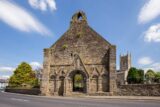St Crónan’s Romanesque Church
A former church, now situated on the site of a modern church
Unguided sitesFógra
WARNING: It should be noted that these sites are unguided and a level of care and caution should be maintained during all stages of your visit. The Office Of Public Works (OPW) will not be held responsible for any damages, injuries, or losses that occur
St Crónan’s Romanesque Church
On the grounds of todays’ St. Cronan’s Church of Ireland at Roscrea, County Tipperary, a section of the original Romanesque church from the 12th century still stands. The remainder of the original structure was deconstructed in the 19th century, when stones and other building materials from the medieval church were utilised in the construction of the new Anglican church in 1812.
What stands today amounts to a western gable end which would once have led churchgoers into the nave of the church; short lengths of the nave still extend slightly into the churchyard from what remains. The decorated doorway includes chevrons, round arches, steep pitched eaves and blind (that is, closed, or, sealed up) arcading in its design. To either side of this ornate doorway are four of these blind arcades, which may once have contained statues of saints. Over the doorway is a more prominent figure of an ecclesiastic, possibly a representation of the Irish saint known as Cronan mac Odhran. Extending above the doorway is a triangular relief carving, and above this a bell-cot still protrudes, clearly added at some later period from the initial founding of this ecclesiastical settlement.
Contemporary to the church remains is the 20-metre high Round Tower directly across Church Street. This tower has a south-east facing doorway and three windows along its height; the east window bears several carvings, including an axe, a single masted boat and a cross. It was struck by lightning in 1131, and despite its repair and restoration it would have been originally higher than it is today. Metres from the tower the Black Mills has been turned into a museum and a centre for visitors run by the Office of Public Works – among other artefacts it contains the High Cross of St. Cronan (a replica stands in its original position to the right of the Romanesque doorway). The High Cross is a ringed, sandstone crucifix, with the figure of Christ crucified on one side and that of an ecclesiastic, probably another representation of Cronan, on the other. On the north and south facing sides are representations of the Biblical figures Adam, Eve and the Fall of Man.
The church owes its original foundation to St. Cronan in the late 6th century. The patron of Roscrea, Cronan had already established a monastery at nearby Sean Ross (Old Wood) where ruins of a later Augustinian structure still stand not far from the town to this day. Sean Ross monastery, however, proved to be too wild and isolated, and the folklore tells of pilgrims getting lost in trying to locate it. Cronan thereafter moved his spiritual establishment to what was then the main highroad, known as the Slighe Dhála near the more easily accessible Wood of Cré. Hence, about this new monastery would the historic town of Roscrea grow.
While the church remains at Roscrea are of a later Romanesque structure, we do have some accounts and several artefacts that can inform us of the earlier history of Roscrea Church prior to the Augustinian takeover and the later Norman invasion. Lists of notable monastic figures and Munster Kings are associated with Roscrea in various Irish Annals:
25 abbots or superiors of Roscrea Abbey after St. Cronan, commencing with the Abbot Fiangus who… died in the year 800, and ending with Conaig O’Haengusa, “Superior of the Cannons in Roscrea”, who… died in 1173… King Cormac McCulenain in 909, ordered by will that his royal robes, embroidered with gold, and enriched with precious stones, should be deposited in this Abbey.”[1]
It seems that Roscrea held a great deal of importance for the Munster Kings as prior to its being taken by Norman forces during the reign of King John of England in 1213, they were contested in the area by the armies of King Murtagh, who wished to retain Roscrea.
Aside from its spiritual importance, the church at Roscrea would have also provided opportunities for learning, and we know that artists, craftsmen and smiths would have also provided their services throughout the area. While the Roscrea Pillar has been relocated on numerous occasions, its ornamentation includes carvings of various animals, including one which has been identified as an elephant, suggesting that in the locality there was knowledge of foreign animals. The 9th century Roscrea Brooch, currently on display in the National Museum, is a remarkable piece of high-quality cast silverwork with amber bosses and gold filigree. It contains depictions of animals in the Celtic, tubular-rounded style, akin to most brooches from the same period. While there is scholarly debate about whether the brooch was discovered in Roscrea town or in the neighbourhood, it nevertheless indicates the prosperity of the place during this time.
Of these artefacts probably none is more interesting or important than the Book of Dimma, currently housed in Trinity College Dublin. Containing the signature of a scribe named Dimma mac Nathi, this 74-page vellum manuscript contains cursive script copies of the Gospels written in Latin as well as Celtic-style illustrations, quite similar to some of those found in the Book of Kells. While Dimma certainly copied and illustrated the first three books of the Gospel, Matthew, Mark and Luke, into this ornate manuscript, the final Gospel, that of John, is clearly the work of another, unnamed, scribe.
Despite this, a legend has grown concerning a miracle attributed to St. Cronan which saw to the book’s composition:
The blessed father Cronan asked a certain scribe to write four gospels for him; the scribe himself was now called Dimma, and he refused to write to the saint except for one day. And the saint said to him: Write without ceasing until the sun sets on you. This the scribe promised. And the saint appointed him a place to write; but by the grace of St. Cronan and by the divine virtue and power, the rays of the sun were always in that place for forty days and forty nights without ceasing, and the scribe was not weary for so long, nor did he feel wearied by such continuous labour, nor was he burdened by the desire for food or drink or sleep. For he thought that the time of forty days and nights was one day: and in this time he wrote the four Gospels… and the religious men with St. Cronan, telling him that he had written in the space of forty days and nights, without obscurity, gave thanks to the power of Christ, and others who were there.[2]
It is believed that the manuscript was persevered at Roscrea Church until the time of the Dissolution of the Monasteries in the 16th century, from which time it passed through many hands. The book is itself stored in a protective casing known as a cumdach (a casket or shrine), gifted by the O’Carroll (Irish, Ó Cearbhaill) clan of Éile to the ecclesiastics of Roscrea in the 12th century to protect the manuscript. As both St. Cronan and his father Odhran were natives of the Éile territory of the O’Carroll clan, it is clear the O’Carroll’s were still keen to associate themselves with the saint centuries after his death. The front of the cumdach has a Latin inscription which translates as:
Thadeus Ua Cearbaill, king of Éile had me gilt; the lord Domnall Ua Cuanáin, Coarb, was the last to restore me; Tomás the craftsman fashioned this shrine.[3]
Visit Historic Environment Viewer for more information on Roscrea Church
Protect our Past - Click here to read about the importance of protecting our country’s unique heritage sites
This national monument is protected in accordance with the National Monuments Acts 1930 to 2014
[1] Thomas Lalor Cooke, History of Birr (Dublin, 1875), pp. 134-5.
[2] R.I. Best, ‘On the subscriptions in the Book of Dimma’, Hermathena, TCD 1926, Vol. 20, No. 44, pp. 84-100, available: https://www.jstor.org/stable/23037075?read-now=1&seq=7#page_scan_tab_contents.
[3] George Cunningham, The Modern Story of St. Cronan’s Roscrea, Co. Tipperary: its clergy, people and parochial buildings (Roscrea, 2001), p. 4.
Gailearaí
Suíomhanna cóngarach
Caisleán agus Gairdíní Ros Cré, agus Teach Damer/ Muilte Dubha
Áit a léiríonn cumhacht mheánaoiseach agus galántacht ón ochtú haois déag
Timpeall 0.2 km ón
Caisleán agus Gairdíní Phort Omna
Breáthacht ón seachtú haois déag ar bhruacha Loch Deirgeirt
Timpeall 32.0 km ón
Gairdíní Heywood
Tírdhreach suaimhneach agus rómánsúil ar thaobh cnoic
Timpeall 34.3 km ón


